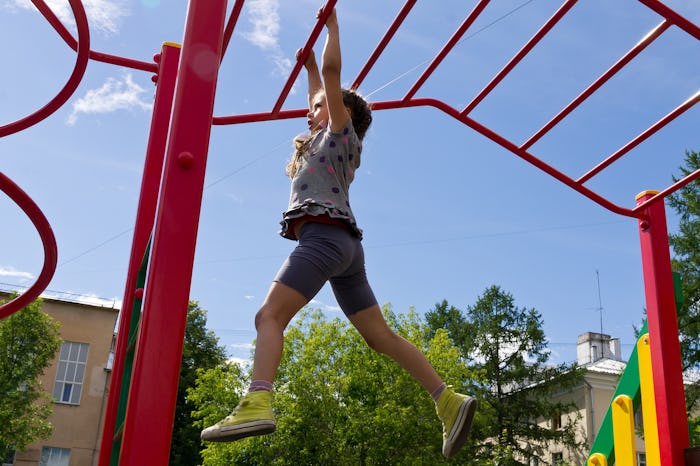Life

Every Parent Should Watch Out For These Common Playground Dangers
Even though you probably tend to think of today's playgrounds as less dangerous than the ones you played on (with their metal slides and patches of asphalt under the swings), playground injuries are still surprisingly common. Sure, the asphalt has been replaced with soft, shock-absorbent material or wood chips, and more of the equipment is made out of plastic than rusty steel. But a shocking number of kids still end up in the ER every day needing stitches, casts, and countless other types of treatment after a day of play. So what are the most common dangers at the playground?
Whether their injuries are the result of faulty equipment, using equipment improperly, or just plain bad luck, over 200,000 children are injured on America's playgrounds, reported the National Program for Playground Safety. Unfortunately, while some efforts have been made to address the issue of unsafe playgrounds, there is no "nationally coordinated effort," according to the NPPS. That means parents have to exercise caution when it comes to which playgrounds their families frequent and whether or not certain things should be avoided.
And, obviously, kids (especially young kids) should be supervised on the playground. There's no way to make it through childhood completely unscathed, but the more breaks avoided, the better.
1Falls
This won't come as a huge surprise to any toddler parents out there, but falls account for over 75 percent of all playground-related injuries, per the Children's Safety Network.
Falls are a problem everywhere kids go, naturally. In fact, according to the Centers for Disease Control, falls are the leading cause of non-fatal injuries for all children ages 0 to 19 (with approximately 8,000 children being treated in U.S. emergency rooms for fall-related injuries every day). But falls at the playground have the potential to be especially dangerous. A study conducted by researchers from The University of Calgary Studies found that most injury-inducing playground falls occur on equipment requiring upper body strength like monkey bars, track rides and jungle gyms, meaning kids are sometimes falling from a considerable height. So the upshot is, keep an eye on your kid when they're climbing, and make sure they don't overestimate the strength of their arms when it comes to monkey bars, etc.
2Burns
After people finally figured out that scalding hot aluminum sliding boards were probably a bad plan because metal slides can give kids severe burns, a majority of playgrounds either coated metal equipment with heat-reducing paint or replaced it with plastic. Still, burns happen. A fact sheet about Burn Safety Awareness on Playgrounds from the U.S. Consumer Product Safety Commission warned that metal isn't the only material that can cause thermal burns: Out of nearly 30 thermal burn incidents between 2001‐2008, 10 were associated with plastic, rubber, or other nonmetal surfaces, and seven were associated with metal surfaces. And it doesn't even have to be all that hot outside: One child got serious second-degree burns on a plastic slide on a 74 degree day!
3Slide-Related Broken Legs
A 2017 study by the American Academy of Pediatrics found that more than 350,000 children under 6 years of age were "injured on slides in the United States from 2002 to 2015," and of the injuries that were reported, the highest percentage of injuries happened to toddlers aged 12 to 23 months. Many of these injuries were leg fractures, unsurprisingly.
One way to prevent this is to avoid riding down a slide with your child on your lap. New York-based mother of three Heather Clare's 1-year-old daughter suffered multiple leg fractures when they rode down a slide together in 2015, as PEOPLE reported, after which both ER and orthopedic doctors told Clare that slide-related injuries are very common.
4Cuts & Scrapes
When you're checking to see if a playground is safe, look out for "protruding objects with sharp, unfinished or otherwise awkward edges, such as bolts or S-shaped hooks," advised the International Association of Certified Home Inspectors on its website. These can cut a child or catch or become entangled with clothing (leading to falls or even strangulation). Additionally, look out for the following signs of disrepair listed by the NPPS: splinters in wood equipment, rust on metal equipment, cracks in plastic and S-hooks that aren't closed.
5Swing-Related Injuries
Playgrounds can be hazardous even when they're in your own backyard. Swings are responsible for the most injuries on home playgrounds, according to the CDC: Between 1990 and 2000, 147 children ages 14 and younger died from playground-related injuries; 70 percent of these happened on home playgrounds (56 percent from strangulation and 20 percent from falls).
6Concussions
A study published in the journal Pediatrics conducted by the CDC found that concussions from playground equipment are on the rise among kids ages 14 and under, with the two worst offenders being swings and monkey bars. (Another check in the "cons" column for swings.)